Child Disability: Annotated Bibliography, Summary, and Analysis
VerifiedAdded on 2022/08/26
|6
|1279
|16
Homework Assignment
AI Summary
This assignment provides an analysis of three research papers focusing on children with disabilities and the issues they face within the child protection system. The papers by Taylor, Stalker, and Stewart (2015), Stalker and McArthur (2012), and Schilling, Kirkham, and Schinke (1986) all highlight the increased risk of abuse and neglect faced by disabled children. The assignment includes annotated bibliographies of each paper, summarizing their methodologies, findings, and limitations. The studies utilize both qualitative and quantitative research methods, with some papers focusing on practitioner perspectives and others on systemic reviews. A key finding across the studies is the potential for CPS workers to overlook or misidentify disabilities, leading to inadequate protection. The assignment concludes with a summary that compares and contrasts the research, identifies best practices (such as assessing children's needs and adapting policies), and highlights the need for increased awareness and training for professionals involved in child protection. It emphasizes the importance of recognizing the unique vulnerabilities of disabled children and tailoring interventions accordingly.
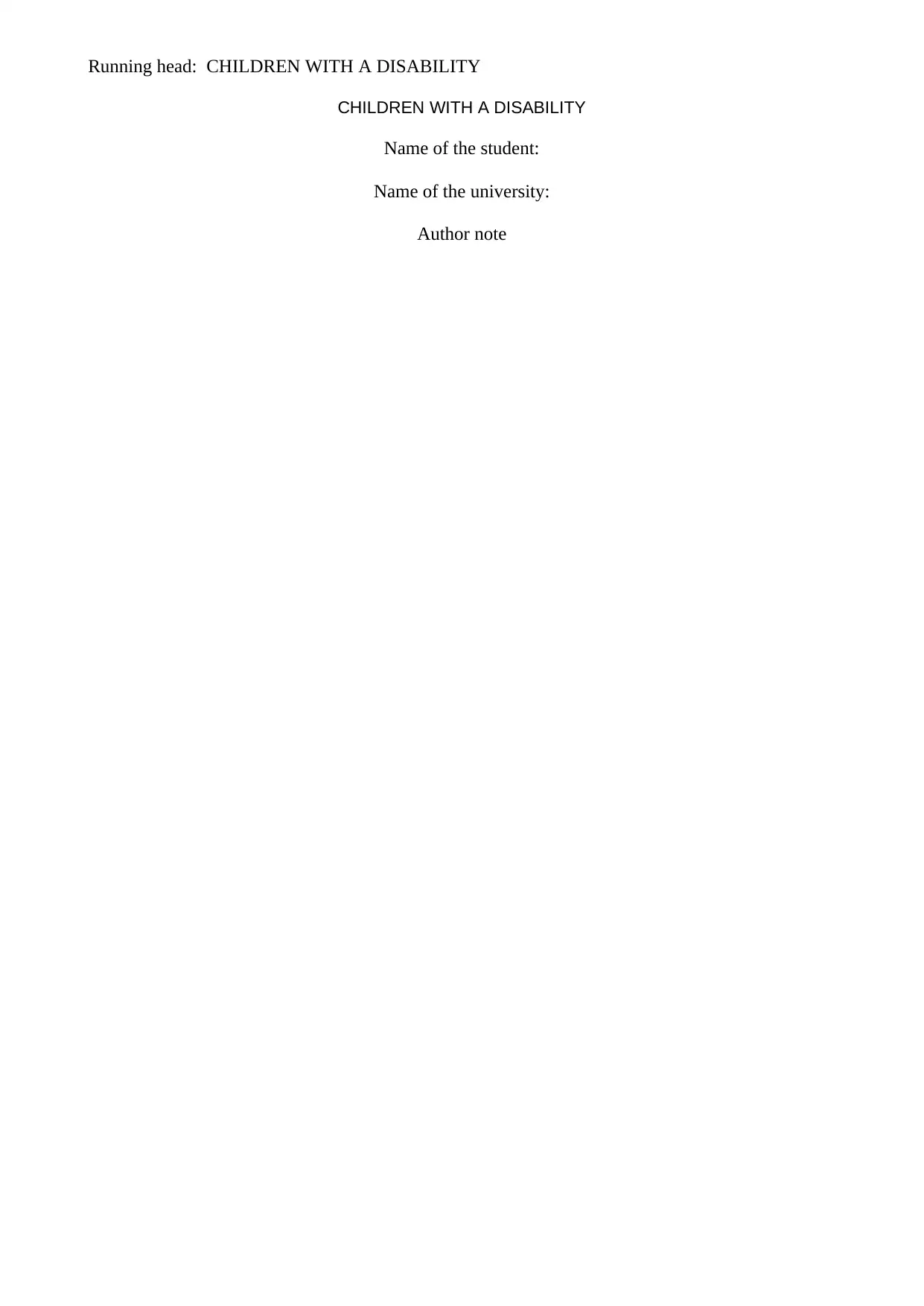
Running head: CHILDREN WITH A DISABILITY
CHILDREN WITH A DISABILITY
Name of the student:
Name of the university:
Author note
CHILDREN WITH A DISABILITY
Name of the student:
Name of the university:
Author note
Paraphrase This Document
Need a fresh take? Get an instant paraphrase of this document with our AI Paraphraser
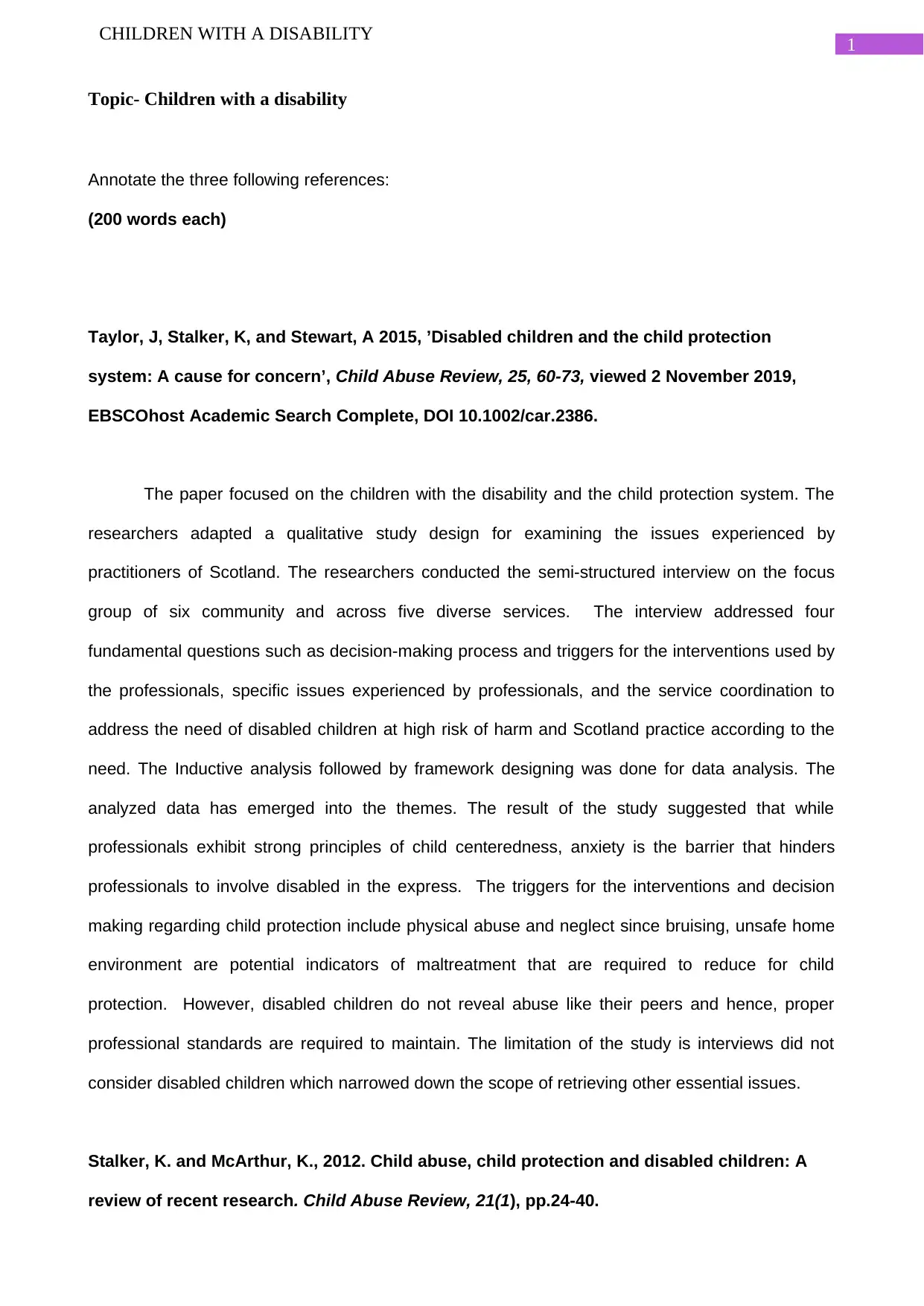
1
CHILDREN WITH A DISABILITY
Topic- Children with a disability
Annotate the three following references:
(200 words each)
Taylor, J, Stalker, K, and Stewart, A 2015, ’Disabled children and the child protection
system: A cause for concern’, Child Abuse Review, 25, 60-73, viewed 2 November 2019,
EBSCOhost Academic Search Complete, DOI 10.1002/car.2386.
The paper focused on the children with the disability and the child protection system. The
researchers adapted a qualitative study design for examining the issues experienced by
practitioners of Scotland. The researchers conducted the semi-structured interview on the focus
group of six community and across five diverse services. The interview addressed four
fundamental questions such as decision-making process and triggers for the interventions used by
the professionals, specific issues experienced by professionals, and the service coordination to
address the need of disabled children at high risk of harm and Scotland practice according to the
need. The Inductive analysis followed by framework designing was done for data analysis. The
analyzed data has emerged into the themes. The result of the study suggested that while
professionals exhibit strong principles of child centeredness, anxiety is the barrier that hinders
professionals to involve disabled in the express. The triggers for the interventions and decision
making regarding child protection include physical abuse and neglect since bruising, unsafe home
environment are potential indicators of maltreatment that are required to reduce for child
protection. However, disabled children do not reveal abuse like their peers and hence, proper
professional standards are required to maintain. The limitation of the study is interviews did not
consider disabled children which narrowed down the scope of retrieving other essential issues.
Stalker, K. and McArthur, K., 2012. Child abuse, child protection and disabled children: A
review of recent research. Child Abuse Review, 21(1), pp.24-40.
CHILDREN WITH A DISABILITY
Topic- Children with a disability
Annotate the three following references:
(200 words each)
Taylor, J, Stalker, K, and Stewart, A 2015, ’Disabled children and the child protection
system: A cause for concern’, Child Abuse Review, 25, 60-73, viewed 2 November 2019,
EBSCOhost Academic Search Complete, DOI 10.1002/car.2386.
The paper focused on the children with the disability and the child protection system. The
researchers adapted a qualitative study design for examining the issues experienced by
practitioners of Scotland. The researchers conducted the semi-structured interview on the focus
group of six community and across five diverse services. The interview addressed four
fundamental questions such as decision-making process and triggers for the interventions used by
the professionals, specific issues experienced by professionals, and the service coordination to
address the need of disabled children at high risk of harm and Scotland practice according to the
need. The Inductive analysis followed by framework designing was done for data analysis. The
analyzed data has emerged into the themes. The result of the study suggested that while
professionals exhibit strong principles of child centeredness, anxiety is the barrier that hinders
professionals to involve disabled in the express. The triggers for the interventions and decision
making regarding child protection include physical abuse and neglect since bruising, unsafe home
environment are potential indicators of maltreatment that are required to reduce for child
protection. However, disabled children do not reveal abuse like their peers and hence, proper
professional standards are required to maintain. The limitation of the study is interviews did not
consider disabled children which narrowed down the scope of retrieving other essential issues.
Stalker, K. and McArthur, K., 2012. Child abuse, child protection and disabled children: A
review of recent research. Child Abuse Review, 21(1), pp.24-40.
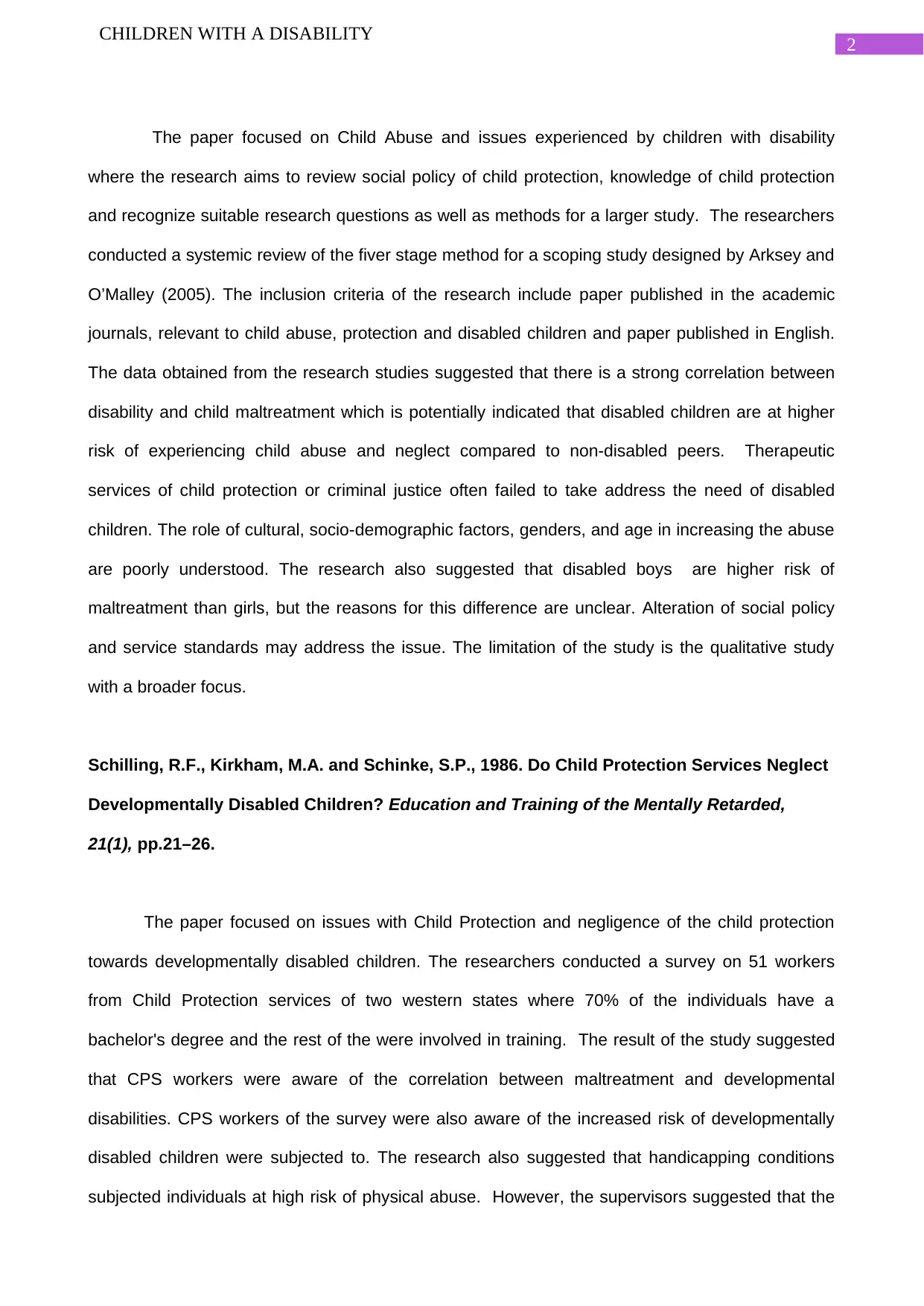
2
CHILDREN WITH A DISABILITY
The paper focused on Child Abuse and issues experienced by children with disability
where the research aims to review social policy of child protection, knowledge of child protection
and recognize suitable research questions as well as methods for a larger study. The researchers
conducted a systemic review of the fiver stage method for a scoping study designed by Arksey and
O’Malley (2005). The inclusion criteria of the research include paper published in the academic
journals, relevant to child abuse, protection and disabled children and paper published in English.
The data obtained from the research studies suggested that there is a strong correlation between
disability and child maltreatment which is potentially indicated that disabled children are at higher
risk of experiencing child abuse and neglect compared to non-disabled peers. Therapeutic
services of child protection or criminal justice often failed to take address the need of disabled
children. The role of cultural, socio-demographic factors, genders, and age in increasing the abuse
are poorly understood. The research also suggested that disabled boys are higher risk of
maltreatment than girls, but the reasons for this difference are unclear. Alteration of social policy
and service standards may address the issue. The limitation of the study is the qualitative study
with a broader focus.
Schilling, R.F., Kirkham, M.A. and Schinke, S.P., 1986. Do Child Protection Services Neglect
Developmentally Disabled Children? Education and Training of the Mentally Retarded,
21(1), pp.21–26.
The paper focused on issues with Child Protection and negligence of the child protection
towards developmentally disabled children. The researchers conducted a survey on 51 workers
from Child Protection services of two western states where 70% of the individuals have a
bachelor's degree and the rest of the were involved in training. The result of the study suggested
that CPS workers were aware of the correlation between maltreatment and developmental
disabilities. CPS workers of the survey were also aware of the increased risk of developmentally
disabled children were subjected to. The research also suggested that handicapping conditions
subjected individuals at high risk of physical abuse. However, the supervisors suggested that the
CHILDREN WITH A DISABILITY
The paper focused on Child Abuse and issues experienced by children with disability
where the research aims to review social policy of child protection, knowledge of child protection
and recognize suitable research questions as well as methods for a larger study. The researchers
conducted a systemic review of the fiver stage method for a scoping study designed by Arksey and
O’Malley (2005). The inclusion criteria of the research include paper published in the academic
journals, relevant to child abuse, protection and disabled children and paper published in English.
The data obtained from the research studies suggested that there is a strong correlation between
disability and child maltreatment which is potentially indicated that disabled children are at higher
risk of experiencing child abuse and neglect compared to non-disabled peers. Therapeutic
services of child protection or criminal justice often failed to take address the need of disabled
children. The role of cultural, socio-demographic factors, genders, and age in increasing the abuse
are poorly understood. The research also suggested that disabled boys are higher risk of
maltreatment than girls, but the reasons for this difference are unclear. Alteration of social policy
and service standards may address the issue. The limitation of the study is the qualitative study
with a broader focus.
Schilling, R.F., Kirkham, M.A. and Schinke, S.P., 1986. Do Child Protection Services Neglect
Developmentally Disabled Children? Education and Training of the Mentally Retarded,
21(1), pp.21–26.
The paper focused on issues with Child Protection and negligence of the child protection
towards developmentally disabled children. The researchers conducted a survey on 51 workers
from Child Protection services of two western states where 70% of the individuals have a
bachelor's degree and the rest of the were involved in training. The result of the study suggested
that CPS workers were aware of the correlation between maltreatment and developmental
disabilities. CPS workers of the survey were also aware of the increased risk of developmentally
disabled children were subjected to. The research also suggested that handicapping conditions
subjected individuals at high risk of physical abuse. However, the supervisors suggested that the
⊘ This is a preview!⊘
Do you want full access?
Subscribe today to unlock all pages.

Trusted by 1+ million students worldwide
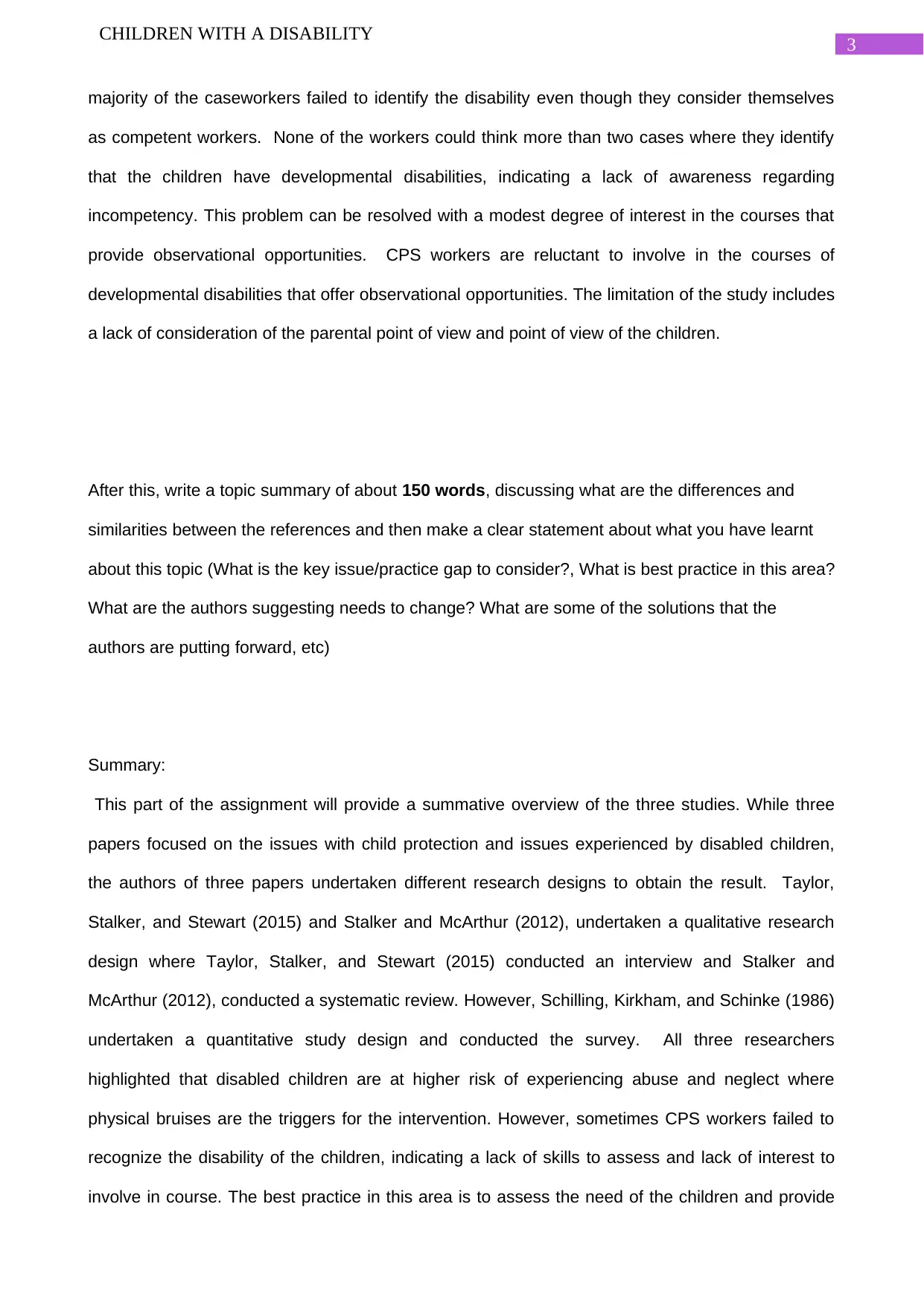
3
CHILDREN WITH A DISABILITY
majority of the caseworkers failed to identify the disability even though they consider themselves
as competent workers. None of the workers could think more than two cases where they identify
that the children have developmental disabilities, indicating a lack of awareness regarding
incompetency. This problem can be resolved with a modest degree of interest in the courses that
provide observational opportunities. CPS workers are reluctant to involve in the courses of
developmental disabilities that offer observational opportunities. The limitation of the study includes
a lack of consideration of the parental point of view and point of view of the children.
After this, write a topic summary of about 150 words, discussing what are the differences and
similarities between the references and then make a clear statement about what you have learnt
about this topic (What is the key issue/practice gap to consider?, What is best practice in this area?
What are the authors suggesting needs to change? What are some of the solutions that the
authors are putting forward, etc)
Summary:
This part of the assignment will provide a summative overview of the three studies. While three
papers focused on the issues with child protection and issues experienced by disabled children,
the authors of three papers undertaken different research designs to obtain the result. Taylor,
Stalker, and Stewart (2015) and Stalker and McArthur (2012), undertaken a qualitative research
design where Taylor, Stalker, and Stewart (2015) conducted an interview and Stalker and
McArthur (2012), conducted a systematic review. However, Schilling, Kirkham, and Schinke (1986)
undertaken a quantitative study design and conducted the survey. All three researchers
highlighted that disabled children are at higher risk of experiencing abuse and neglect where
physical bruises are the triggers for the intervention. However, sometimes CPS workers failed to
recognize the disability of the children, indicating a lack of skills to assess and lack of interest to
involve in course. The best practice in this area is to assess the need of the children and provide
CHILDREN WITH A DISABILITY
majority of the caseworkers failed to identify the disability even though they consider themselves
as competent workers. None of the workers could think more than two cases where they identify
that the children have developmental disabilities, indicating a lack of awareness regarding
incompetency. This problem can be resolved with a modest degree of interest in the courses that
provide observational opportunities. CPS workers are reluctant to involve in the courses of
developmental disabilities that offer observational opportunities. The limitation of the study includes
a lack of consideration of the parental point of view and point of view of the children.
After this, write a topic summary of about 150 words, discussing what are the differences and
similarities between the references and then make a clear statement about what you have learnt
about this topic (What is the key issue/practice gap to consider?, What is best practice in this area?
What are the authors suggesting needs to change? What are some of the solutions that the
authors are putting forward, etc)
Summary:
This part of the assignment will provide a summative overview of the three studies. While three
papers focused on the issues with child protection and issues experienced by disabled children,
the authors of three papers undertaken different research designs to obtain the result. Taylor,
Stalker, and Stewart (2015) and Stalker and McArthur (2012), undertaken a qualitative research
design where Taylor, Stalker, and Stewart (2015) conducted an interview and Stalker and
McArthur (2012), conducted a systematic review. However, Schilling, Kirkham, and Schinke (1986)
undertaken a quantitative study design and conducted the survey. All three researchers
highlighted that disabled children are at higher risk of experiencing abuse and neglect where
physical bruises are the triggers for the intervention. However, sometimes CPS workers failed to
recognize the disability of the children, indicating a lack of skills to assess and lack of interest to
involve in course. The best practice in this area is to assess the need of the children and provide
Paraphrase This Document
Need a fresh take? Get an instant paraphrase of this document with our AI Paraphraser
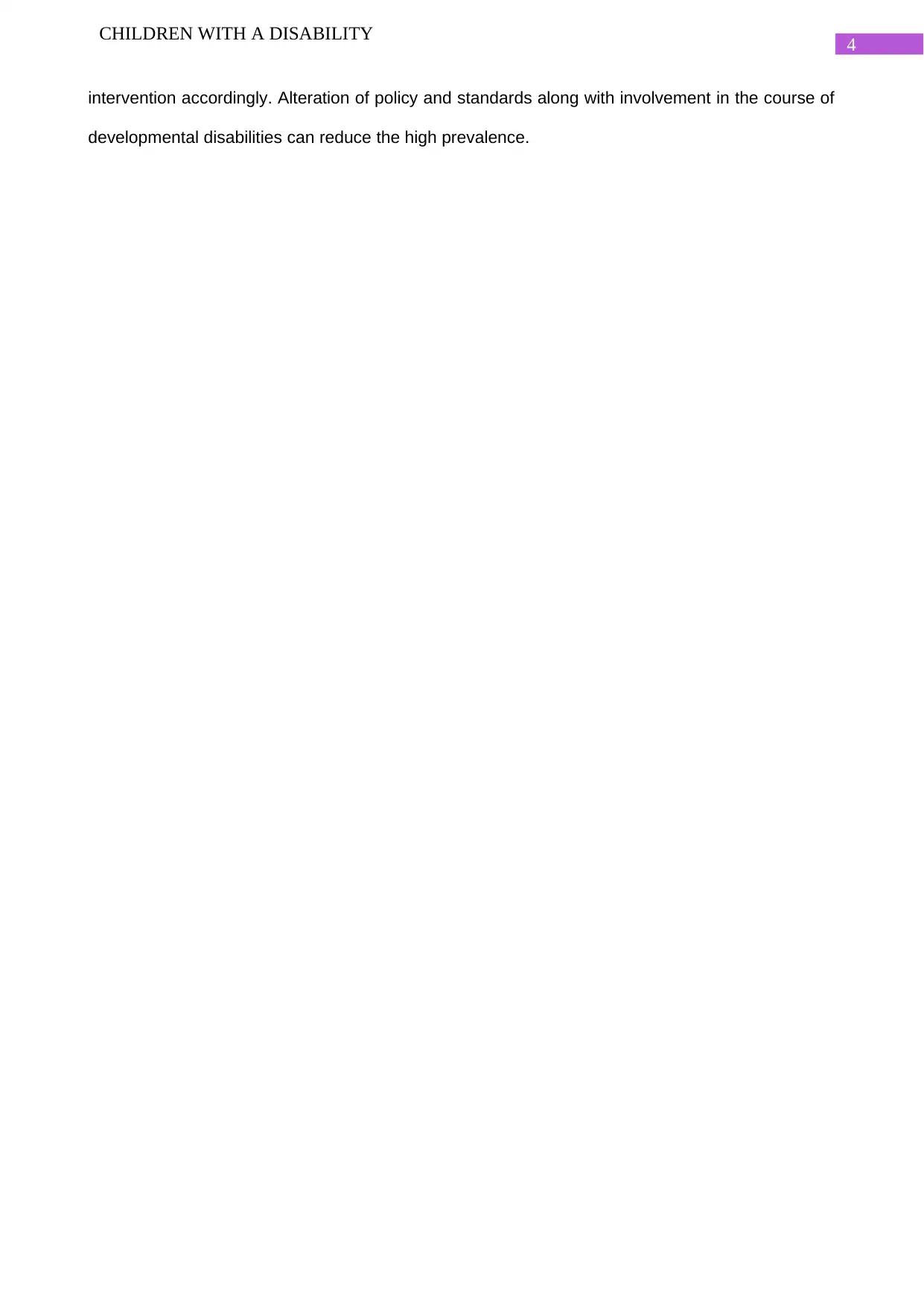
4
CHILDREN WITH A DISABILITY
intervention accordingly. Alteration of policy and standards along with involvement in the course of
developmental disabilities can reduce the high prevalence.
CHILDREN WITH A DISABILITY
intervention accordingly. Alteration of policy and standards along with involvement in the course of
developmental disabilities can reduce the high prevalence.
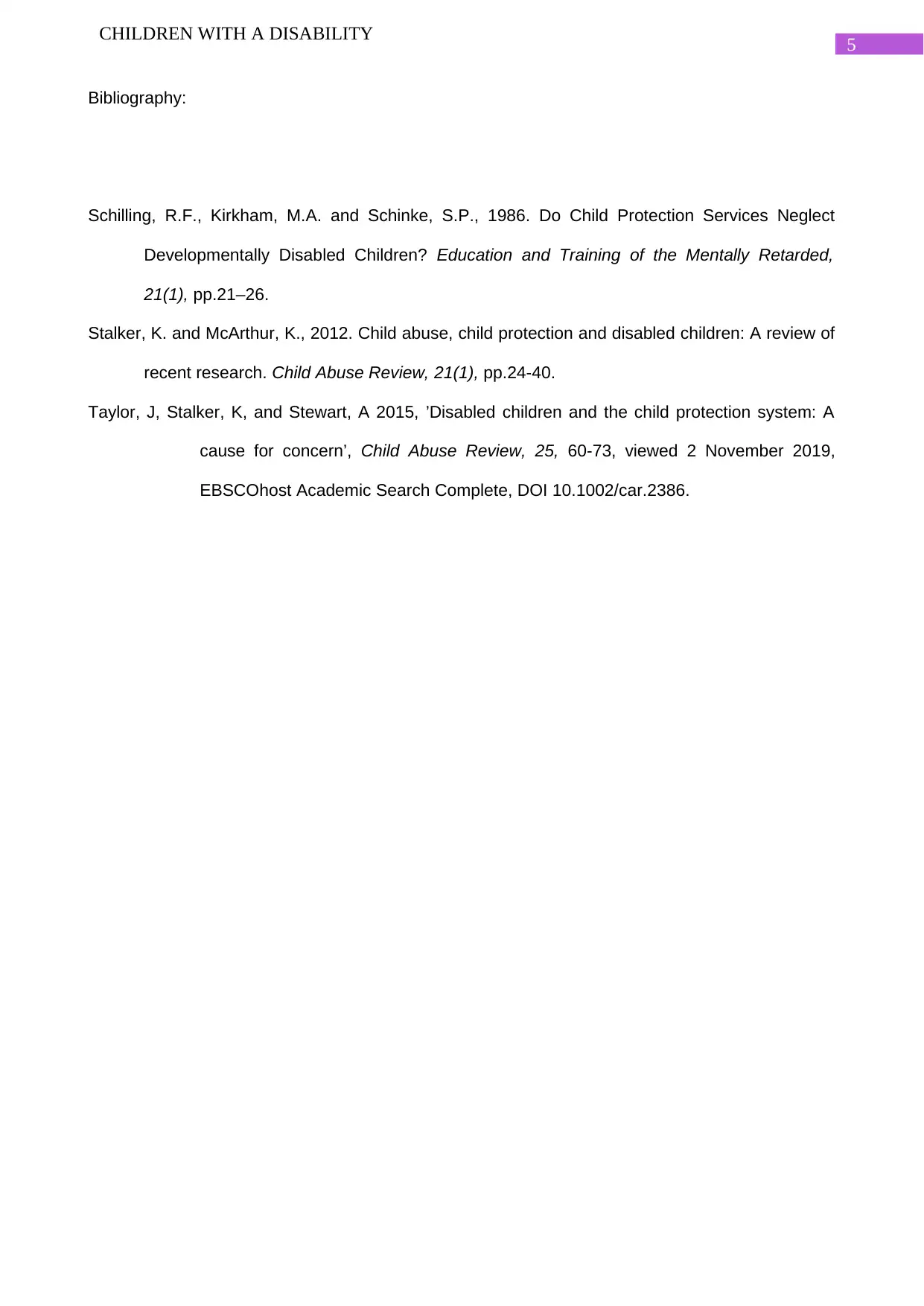
5
CHILDREN WITH A DISABILITY
Bibliography:
Schilling, R.F., Kirkham, M.A. and Schinke, S.P., 1986. Do Child Protection Services Neglect
Developmentally Disabled Children? Education and Training of the Mentally Retarded,
21(1), pp.21–26.
Stalker, K. and McArthur, K., 2012. Child abuse, child protection and disabled children: A review of
recent research. Child Abuse Review, 21(1), pp.24-40.
Taylor, J, Stalker, K, and Stewart, A 2015, ’Disabled children and the child protection system: A
cause for concern’, Child Abuse Review, 25, 60-73, viewed 2 November 2019,
EBSCOhost Academic Search Complete, DOI 10.1002/car.2386.
CHILDREN WITH A DISABILITY
Bibliography:
Schilling, R.F., Kirkham, M.A. and Schinke, S.P., 1986. Do Child Protection Services Neglect
Developmentally Disabled Children? Education and Training of the Mentally Retarded,
21(1), pp.21–26.
Stalker, K. and McArthur, K., 2012. Child abuse, child protection and disabled children: A review of
recent research. Child Abuse Review, 21(1), pp.24-40.
Taylor, J, Stalker, K, and Stewart, A 2015, ’Disabled children and the child protection system: A
cause for concern’, Child Abuse Review, 25, 60-73, viewed 2 November 2019,
EBSCOhost Academic Search Complete, DOI 10.1002/car.2386.
⊘ This is a preview!⊘
Do you want full access?
Subscribe today to unlock all pages.

Trusted by 1+ million students worldwide
1 out of 6
Related Documents
Your All-in-One AI-Powered Toolkit for Academic Success.
+13062052269
info@desklib.com
Available 24*7 on WhatsApp / Email
![[object Object]](/_next/static/media/star-bottom.7253800d.svg)
Unlock your academic potential
Copyright © 2020–2025 A2Z Services. All Rights Reserved. Developed and managed by ZUCOL.




